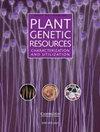菊花形态计量学特征及遗传变异研究
IF 0.7
4区 生物学
Q3 PLANT SCIENCES
Plant Genetic Resources: Characterization and Utilization
Pub Date : 2022-02-08
DOI:10.1017/s1479262121000629
引用次数: 1
摘要
种质鉴定对于估计变异和确定作物改良所需的基因型至关重要。本研究对54个菊花基因型的8个生长性状和14个花性状进行了定性和分类。主成分分析表明,前两个主成分解释了种质资源中存在的大部分变异(>98%)。基因型变异系数为9.41%(叶长/宽比)~ 105.99%(花冠管长),表型变异系数为10.49%(叶长/宽比)~ 106.38%(花冠管长)。除叶长/宽比和花序梗厚度等性状外,其余性状的广义遗传力均高于96%。44对性状间组合在91个可能组合中表现出正的基因型和表型相关。D2分析显示,I和IV集群的基因型差异较大,它们之间的杂交可能有更好的机会获得理想的类型。D2分析证实,聚类IV中的品种即Red D Spoon、Tokyo Soldier、Yellow Reflex和等级聚类表明该品种具有高度的多样性。建议在杂交计划中使用上述基因型,以获得更好的后代。本文章由计算机程序翻译,如有差异,请以英文原文为准。
Morpho-metric characterization and genetic variability studies in chrysanthemum
Germplasm characterization is essential to estimate variation and identify desirable genotypes for crop improvement. The current study was conducted on eight qualitative and 14 quantitative traits related to growth and floral attributes for characterization and grouping of 54 chrysanthemum genotypes. Wide variability was observed among most of the traits and principal component analysis revealed that the first two principal components explained most of the existing variation (>98%) in germplasm. Genotypic coefficient of variation exhibited a wide range from 9.41% (ratio of leaf length/width) to 105.99% (corolla tube length of ray florets), while phenotypic coefficient of variation varied from 10.49% (ratio of leaf length/width) to 106.38% (corolla tube length of ray florets). Broad sense heritability estimates were higher (>96%) for most of the characters, except for traits such as ratio of leaf length/width and peduncle thickness. Forty-four pair-wise inter-trait combinations showed positive genotypic and phenotypic correlations for 91 possible combinations. D2 analysis revealed that genotypes of clusters I and IV to be highly distinct, and hybridization between them might have better chance to obtain desirable types. D2 analysis confirmed that the cultivars in cluster IV namely, Red D Spoon, Tokyo Soldier, Yellow Reflex and hierarchical clustering showed that the cultivar Tokyo Soldier to be highly diverse. It is recommended to use the above genotypes in crossing programme for obtaining better progenies.
求助全文
通过发布文献求助,成功后即可免费获取论文全文。
去求助
来源期刊

Plant Genetic Resources: Characterization and Utilization
Agricultural and Biological Sciences-Agronomy and Crop Science
CiteScore
2.80
自引率
0.00%
发文量
29
审稿时长
>12 weeks
期刊介绍:
Plant Genetic Resources is an international journal which provides a forum for describing the application of novel genomic technologies, as well as their integration with established techniques, towards the understanding of the genetic variation captured in both in situ and ex situ collections of crop and non-crop plants; and for the airing of wider issues relevant to plant germplasm conservation and utilisation. We particularly welcome multi-disciplinary approaches that incorporate both a technical and a socio-economic focus. Technical aspects can cover developments in technologies of potential or demonstrated relevance to the analysis of variation and diversity at the phenotypic and genotypic levels.
 求助内容:
求助内容: 应助结果提醒方式:
应助结果提醒方式:


